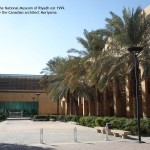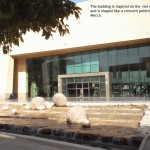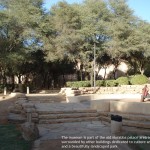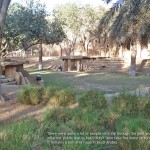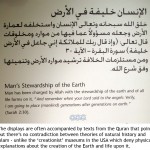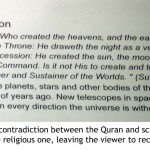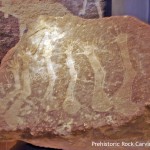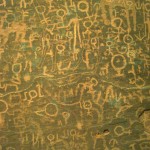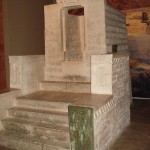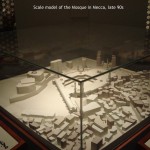The National Museum of Riyadh is a very interesting museum designed by the Canadian architect Raymond Moriyama (figs 1 & 2). It was inaugurated in 1999. It is located on the grounds of the Murabba Palace that was built by King Abdul Aziz in 1936/37 north of what was then Riyadh, a small and congested walled city. Many of the buildings of this palatial complex that fell into disuse in the early 1950s have been beautifully restored, and together with the gardens that surround them they form one of the only large public spaces in Riyadh (figs 3 & 4). Many people come here to stroll, picnic and watch other passers-by.
The collection has several highlights. The first part, ‘Man and the Universe’, attempts to bring together natural history and the Quran (fig 5). Next to the impressive multi-media displays one will find the relevant surahs (figs 6 & 7). Unlike creationist museums in the USA there is no conflict between the results of scientific discovery and religious tenets. When they do not collude, the scientific point of view is stated blithely after surah, allowing the reader to attempt to reconcile them. One finds references to the Quran in many other parts of the museum, sometimes even to justify the general interest in non-Islamic subjects (fig 8).
The standing stones show that parts of the Arabian peninsula were settled long ago (figs 9 & 10). The figures and pictograms on them are evidence of a graphic tradition in the peninsula that leads straight from the 4th millenium BC to the current rage of Louis Vuitton handbags.
It is interesting to see how the jahiliyya period (the ‘era of ignorance’ before the advent of Islam) is treated. I was surprised by the open-minded, scientific and non-doctrinary approach followed in the museum, in starked contrast to the manner in which public life in Riyadh is generally organized. There is no attempt to disparage the idol worshippers; to the contrary, the segment dedicated to the excavations at Qaryat al Faw, including a small temple (fig 12) are very informative. Some interesting multi-media displays project the visitor into ancient village life, before the Islam. The treasure excavated at Thaj in the Eastern Province (fig 13) is another example of the relative refinement of pre-Islamic Saudi culture.
Some informative maps trace the tribal movements, trade routes and commercial activity in the Arabian peninsula around the time of the prophet Mohammed’s birth (figs 14 & 15). Then comes a sensory experience in which the visitor goes through a dark corridor with movement-triggered audio track accompanied by flashes, to impress him/her with the terrible period of ignorance and conflict that preceded the rise of Islam. This brings you to the second part of the museum, dedicated to the history of Islam in the Arabian peninsula (quite meagre) and the first and second Saudi kingdoms thwarted by the Ottomans. This section, as well as the next about the unification of Saudi Arabia in the first decades of the 20th century, is much more ideologically slanted. The Asiris, Hejazis and Shia of the Eastern province might object against the manner in which these historical events are presented. The official history of the unification of the Kingdom, for those who have no patience to read all the texts accompanying the displays, is projected in a movie theatre that can seat more than hundred people at once.
A final section is about Mecca and the Hajj. It includes scale models of the city and the mosque (figs 16 & 17), and a lot of photographs documenting the experience of the Hajj throughout the 20th century. However tired you may be after visiting all the other rooms of the museum, this part commands your attention once again. The photograph of the Ka’aba standing as the tallest building in a low-rise city, with old houses climbing the hillsides (fig 18), is a powerful reminder of how Mecca used to be before the commercial high-rise developments in the city took off.
All together the visit of museum and the surrounding area was my most pleasurable experience of Riyadh. Two caveats for prospective visitors: call the museum before visiting to make sure it is accessible (there are family hours and frequent holidays); and I could find nothing to eat or drink on the grounds, despite several cafetarias being advertised on the floorplans in and around the museum.

